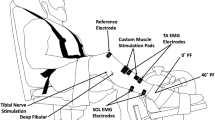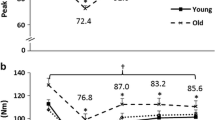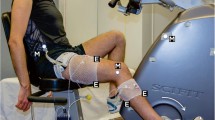Abstract
Previous investigators have reported velocity-dependent strength loss for single-joint actions following acute eccentric exercise. The extent to which velocity influences recovery of multi-joint function is not well documented. Our main purpose was to compare alterations in maximal cycling power produced across a range of pedaling rates following eccentric exercise. An additional purpose was to determine the extent to which changes in rating of perceived exertion (RPE) associated with submaximal cycling reflect changes in maximal cycling power. Eighteen cyclists performed baseline trials of maximal and submaximal single-leg concentric cycling immediately before and 24 and 48 h after acute submaximal single-leg eccentric (151 ± 32 W, 487 ± 107 s) and concentric (148 ± 21 W, 488 ± 79 s) cycling trials. Maximum cycling power (apex of power–pedaling rate relationship; P max) was assessed using inertial-load cycling, and powers produced at 65, 110 and 155 rpm were also analyzed. Compared to baseline, P max was reduced (11–13%) at 24–48 h in the eccentric leg (P < 0.001). Power produced at 65, 110 and 155 rpm was reduced by similar relative magnitudes (11–15%) at 24–48 h in the eccentric leg. RPE increased (15–18%) at 24–48 h in the eccentric leg (P < 0.001). Magnitudes of relative changes in RPE did not differ from those for P max. There were no alterations in the concentric leg. Our results indicated a global, rather than velocity-specific, reduction in neuromuscular function. Such a global reduction does not support the notion of fiber-type specific damage from eccentric exercise. The similar relative changes in RPE and P max suggest that increased exertion may reflect the need to recruit additional motor units to produce the same submaximal power.




Similar content being viewed by others
References
Asp S, Daugaard JR, Kristiansen S, Kiens B, Richter EA (1998) Exercise metabolism in human skeletal muscle exposed to prior eccentric exercise. J Physiol 509(Pt 1):305–313
Borg G (1970) Perceived exertion as an indicator of somatic stress. Scand J Rehabil Med 2:92–98
Byrne C, Eston R (2002) The effect of exercise-induced muscle damage on isometric and dynamic knee extensor strength and vertical jump performance. J Sports Sci 20:417–425
Byrne C, Eston RG, Edwards RH (2001) Characteristics of isometric and dynamic strength loss following eccentric exercise-induced muscle damage. Scand J Med Sci Sports 11:134–140
Byrne C, Twist C, Eston R (2004) Neuromuscular function after exercise-induced muscle damage: theoretical and applied implications. Sports Med 34:49–69
Carmichael MD, Davis JM, Murphy EA, Brown AS, Carson JA, Mayer E, Ghaffar A (2005) Recovery of running performance following muscle-damaging exercise: relationship to brain IL-1beta. Brain Behav Immun 19:445–452
Chourasia AO, Sesto ME, Block WF, Radwin RG (2009) Prolonged mechanical and physiological changes in the upper extremity following short-term simulated power hand tool use. Ergonomics 52:15–24
Clarkson PM, Hubal MJ (2002) Exercise-induced muscle damage in humans. Am J Phys Med Rehabil 81:S52–S69
Crameri RM, Langberg H, Teisner B, Magnusson P, Schroder HD, Olesen JL, Jensen CH, Koskinen S, Suetta C, Kjaer M (2004) Enhanced procollagen processing in skeletal muscle after a single bout of eccentric loading in humans. Matrix Biol 23:259–264
Crameri RM, Aagaard P, Qvortrup K, Langberg H, Olesen J, Kjaer M (2007) Myofibre damage in human skeletal muscle: effects of electrical stimulation versus voluntary contraction. J Physiol 583:365–380
Davies RC, Eston RG, Poole DC, Rowlands AV, DiMenna F, Wilkerson DP, Twist C, Jones AM (2008) Effect of eccentric exercise-induced muscle damage on the dynamics of muscle oxygenation and pulmonary oxygen uptake. J Appl Physiol 105:1413–1421
Deschenes MR, Brewer RE, Bush JA, McCoy RW, Volek JS, Kraemer WJ (2000) Neuromuscular disturbance outlasts other symptoms of exercise-induced muscle damage. J Neurol Sci 174:92–99
Elmer SJ, Martin JC (2010) Joint-specific power loss following eccentric exercise. Med Sci Sports Exerc 42:1723–1730
Elmer SJ, Madigan ML, LaStayo PC, Martin JC (2010) Joint-specific power absorption during eccentric cycling. Clin Biomech (Bristol, Avon) 25:154–158
Eston RG, Finney S, Baker S, Baltzopoulos V (1996) Muscle tenderness and peak torque changes after downhill running following a prior bout of isokinetic eccentric exercise. J Sports Sci 14:291–299
Friden J, Sjostrom M, Ekblom B (1983) Myofibrillar damage following intense eccentric exercise in man. Int J Sports Med 4:170–176
Gibala MJ, MacDougall JD, Tarnopolsky MA, Stauber WT, Elorriaga A (1995) Changes in human skeletal muscle ultrastructure and force production after acute resistance exercise. J Appl Physiol 78:702–708
Gleeson M, Blannin AK, Zhu B, Brooks S, Cave R (1995) Cardiorespiratory, hormonal and haematological responses to submaximal cycling performed 2 days after eccentric or concentric exercise bouts. J Sports Sci 13:471–479
Golden CL, Dudley GA (1992) Strength after bouts of eccentric or concentric actions. Med Sci Sports Exerc 24:926–933
Hinkle DE, Wiersma W, Jurs SG (1998) Applied statistics for the behavioral sciences. Houghton Mifflin Company, Boston
Ingalls CP, Warren GL, Williams JH, Ward CW, Armstrong RB (1998) E–C coupling failure in mouse EDL muscle after in vivo eccentric contractions. J Appl Physiol 85:58–67
Jones DA, Newham DJ, Round JM, Tolfree SE (1986) Experimental human muscle damage: morphological changes in relation to other indices of damage. J Physiol 375:435–448
Malm C, Sjodin TL, Sjoberg B, Lenkei R, Renstrom P, Lundberg IE, Ekblom B (2004) Leukocytes, cytokines, growth factors and hormones in human skeletal muscle and blood after uphill or downhill running. J Physiol 556:983–1000
Marginson V, Rowlands AV, Gleeson NP, Eston RG (2005) Comparison of the symptoms of exercise-induced muscle damage after an initial and repeated bout of plyometric exercise in men and boys. J Appl Physiol 99:1174–1181
Martin JC, Wagner BM, Coyle EF (1997) Inertial-load method determines maximal cycling power in a single exercise bout. Med Sci Sports Exerc 29:1505–1512
Martin JC, Brown NA, Anderson FC, Spirduso WW (2000) A governing relationship for repetitive muscular contraction. J Biomech 33:969–974
Michaut A, Pousson M, Babault N, Van Hoecke J (2002) Is eccentric exercise-induced torque decrease contraction type dependent? Med Sci Sports Exerc 34:1003–1008
Millet GY, Lepers R, Maffiuletti NA, Babault N, Martin V, Lattier G (2002) Alterations of neuromuscular function after an ultramarathon. J Appl Physiol 92:486–492
Newham DJ, Jones DA, Clarkson PM (1987) Repeated high-force eccentric exercise: effects on muscle pain and damage. J Appl Physiol 63:1381–1386
Sargeant AJ, Dolan P (1987) Human muscle function following prolonged eccentric exercise. Eur J Appl Physiol Occup Physiol 56:704–711
Scott KE, Rozenek R, Russo AC, Crussemeyer JA, Lacourse MG (2003) Effects of delayed onset muscle soreness on selected physiological responses to submaximal running. J Strength Cond Res 17:652–658
Sesto ME, Radwin RG, Best TM, Richard TG (2004) Upper limb mechanical changes following short duration repetitive eccentric exertions. Clin Biomech (Bristol, Avon) 19:921–928
Sesto ME, Radwin RG, Block WF, Best TM (2005a) Anatomical and mechanical changes following repetitive eccentric exertions. Clin Biomech (Bristol, Avon) 20:41–49
Sesto ME, Radwin RG, Richard TG (2005b) Short-term changes in upper extremity dynamic mechanical response parameters following power hand tool use. Ergonomics 48:807–820
Sherman WM, Armstrong LE, Murray TM, Hagerman FC, Costill DL, Staron RC, Ivy JL (1984) Effect of a 42.2-km footrace and subsequent rest or exercise on muscular strength and work capacity. J Appl Physiol 57:1668–1673
Twist C, Eston R (2005) The effects of exercise-induced muscle damage on maximal intensity intermittent exercise performance. Eur J Appl Physiol 94:652–658
Twist C, Eston RG (2009) The effect of exercise-induced muscle damage on perceived exertion and cycling endurance performance. Eur J Appl Physiol 105:559–567
Warren GL, Lowe DA, Hayes DA, Karwoski CJ, Prior BM, Armstrong RB (1993) Excitation failure in eccentric contraction-induced injury of mouse soleus muscle. J Physiol 468:487–499
Woltring HJ (1986) A FORTRAN package for generalized, cross validatory spline smoothing and differentiation. Adv Eng Softw 8:104–113
Acknowledgments
This investigation was supported by the Gatorade Sports Science Institute. The authors would like to sincerely thank the participants who took part in this study, for their enthusiastic efforts in performing the cycling trials, and the undergraduate students in the Neuromuscular Function Laboratory, for their assistance with the data collection.
Author information
Authors and Affiliations
Corresponding author
Additional information
Communicated by Susan Ward.
Rights and permissions
About this article
Cite this article
Elmer, S.J., McDaniel, J. & Martin, J.C. Alterations in neuromuscular function and perceptual responses following acute eccentric cycling exercise. Eur J Appl Physiol 110, 1225–1233 (2010). https://doi.org/10.1007/s00421-010-1619-z
Accepted:
Published:
Issue Date:
DOI: https://doi.org/10.1007/s00421-010-1619-z




